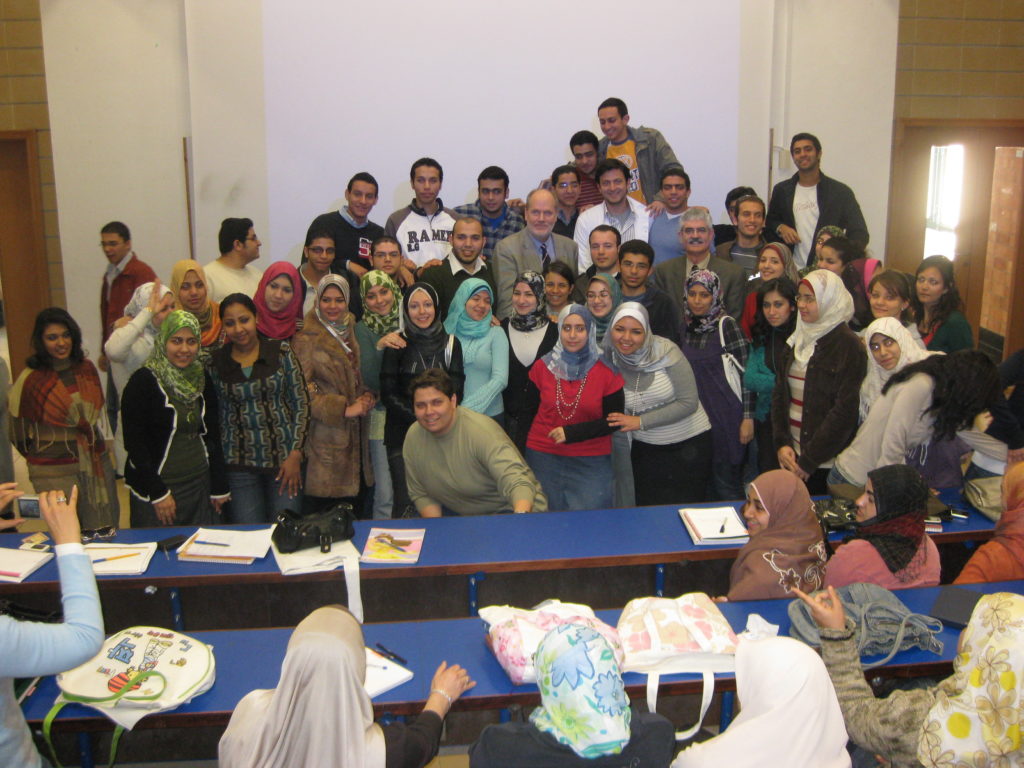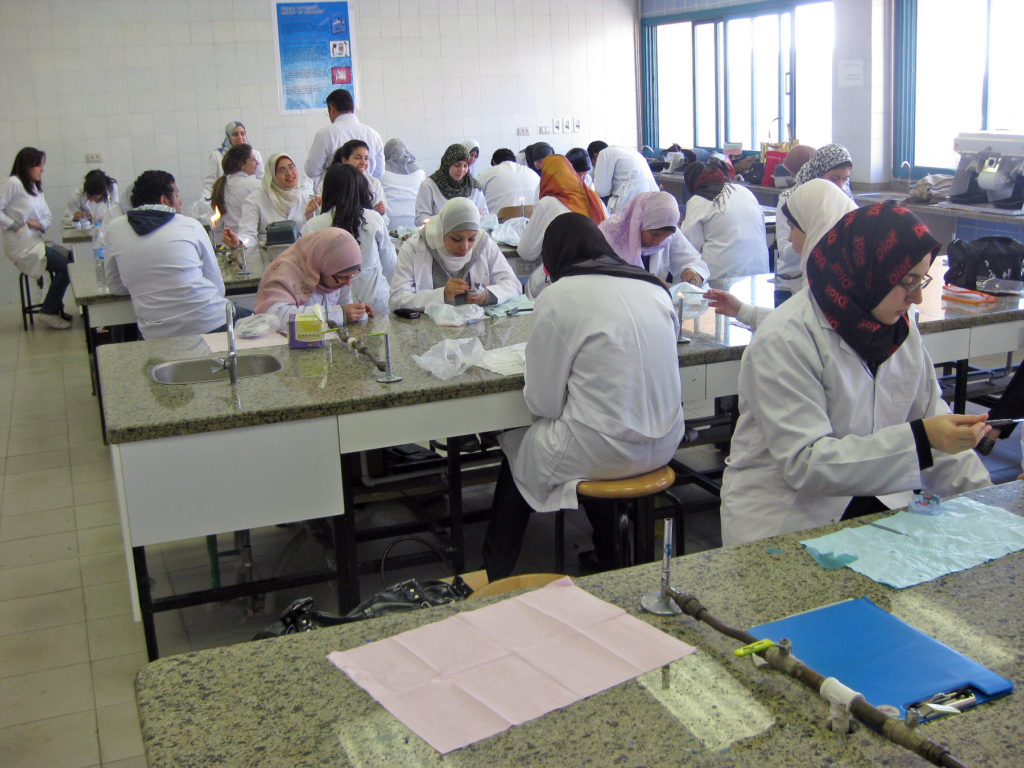By Eric K. Curtis, DDS, MA
For some time now, the planet’s skin has been tightening. It’s as if the whole earth has been trying to merge and integrate, even coalesce, at least in terms of connectivity and commerce. The telephone made the world accessible. Television made the world familiar. Jet propulsion made the world small. The personal computer made the world—as journalist Thomas Friedman famously phrased it—flat. These days, the world is more open and competitive than ever before, and on its newly level, equal-opportunity playing field the Arthur A. Dugoni School of Dentistry lately has been busy exercising, reaching out in fresh, exciting directions. The world is reaching back. Welcome to Pacific’s world of global initiatives in dental education.
The dental school has a long history of promoting international relationships. When I graduated in 1985, faculty members Walter Hall and Don Strub encouraged me to apply for a position at the dental polyclinic of the Centre Hospitalier Universitaire Vaudois in Lausanne, Switzerland, where I would follow a string of Pacific grads, including Drs. Woody Isch ’84, Bill Dorfman ’83, Karin Hansen ’83 and Paul Griffith ’82, into the pale green corridors of the Service Odonto-stomatologique. In 1987 the school brought its cross-cultural proclivities home when it inaugurated the International Dental Studies (IDS) program, enabling foreign-trained dentists to earn a DDS degree in the U.S. The Dugoni School of Dentistry’s international orientation went from program to policy with the development of its 2007 Strategic Plan, which identified as a key directional goal “to become an international leader in educational innovation and professional development.”
Yet even in their nascent stages, Dugoni School of Dentistry’s international initiatives have already yielded significant fruit. “We’re interested in these relationships because both sides grow,” says Nadershahi.
A clutch of congruent interests moved the school to that intercontinental tipping point. Pacific’s main campus in Stockton, launching its own University-wide international initiative, the Global Project of Professional Development, supported the dental school taking a central role in world outreach projects. The dental school’s strategic planning committees realized that transborder connections would neatly serve all seven of the school’s declared core values—humanism, innovation, leadership, reflection, stewardship, collaboration and philanthropy. Dean Patrick J. Ferrillo, Jr. brought with him a strong interest in the international cross-pollination of ideas. (In 2009, for instance, Ferrillo gave a presentation in Rio de Janeiro, “Leading Global Change in Undergraduate and Postgraduate Cariology Education,” at a conference initiating an ambitious 10-year enterprise called the Global Caries Initiative.) And a new generation of dental students, eager to make improvements in the world, was itching to organize trips to developing countries, and students in fact were already making them on their own to places like Guatemala, Peru and the Philippines. “The world has flattened,” says Ferrillo, “and we have the kind of motivated, far-seeing people at the Dugoni School of Dentistry who feel an obligation to share and then go out looking for opportunities. They continuously want to do more.”
As a result, the dental school is now engaged in a number of collaborative educational projects around the world, from the Pacific Rim to the Middle East. One strong sign of the dental school’s commitment was its agreement in 2009 to house the International Federation of Dental Educators and Associations (IFDEA), a 15-year-old organization of several hundred dental schools worldwide previously operated through the American Dental Education Association (ADEA). Ferrillo, who is currently IFDEA president, named Dr. Anders Nattestad, professor of oral and maxillofacial surgery and director of global initiatives at the dental school, as IFDEA executive director. IFDEA’s presence at Pacific also helps facilitate school-sponsored leadership programs for international faculty and administrators. Dental school representatives, including Drs. Ferrillo and Nattestad, Executive Associate Dean Nader Nadershahi ’94, IFDEA vice president, and Foundation Board Member and past Alumni Association President Colin Wong, traveled to China in 2009 to sign a collaborative agreement to develop student and faculty exchanges with the School and Hospital of Stomatology at Wenzhou Medical College, which had already previously sent representatives to the Dugoni School of Dentistry several times. Their visit to China also included meetings and lectures at the Guanghua School Stomatology at Sun Yat-sen University in Guangzhou.
The strategic planning process itself made the dental school’s international inclusivity easy to envision.
Dr. Karl Haden, founder and president of the Academy for Academic Leadership in Atlanta, the strategic plan’s facilitator, also teaches leadership development courses to the dental school faculty that educators from other U.S. institutions also attend. “We have already been including faculty from other schools,” notes Nattestad. “It was natural for us to say, ‘Why don’t we expand?’”
Expansion, indeed. While it regularly welcomes visiting international educators, the Dugoni School of Dentistry recently contracted with the University of Kuwait to provide a much more comprehensive service—a five-year faculty training program. Nadershahi points out that the program will not be the prelude to a brain drain. “We want to develop their graduates to return and become leaders in their own educational institution,” he explains. Young Kuwaiti dental faculty members—one has currently begun and another is scheduled to begin in summer 2011, while a third has gone through the graduate orthodontics program—will spend two years in the AEGD program to learn how our graduates deliver dental care, absorbing not only techniques and materials but also American dental culture and attitudes toward high standards of care. Program participants will then undergo two years of graduate work in education in conjunction with Pacific’s Benerd School of Education, and one year more in practicum teaching back at the dental school, where they will practice managing educational programs.
While the dental school has fostered relationships with schools in China, Japan, Kuwait and Thailand, among others—in 2010 Nadershahi reported to the Alumni Association that 13 initiatives have been started with other dental schools around the world—one of its most shining examples of a sustained, multi-factorial alliance is in Egypt. In 2003 Dr. Enaya Shararah, professor at the University of Alexandria Faculty of Dentistry in Eygpt, was traveling in California and contacted Dr. Eugene LaBarre of Pacific’s Department of Removable Prosthodontics. LaBarre, who had been to Egypt several times with his college rowing team in a show of Cold War-era “ping pong diplomacy,” was willing to talk. Over the course of several visits, Shararah, who hoped to foster a connection with a U.S. dental school to help improve dental education in the Middle East, took a great liking to the faculty and teaching methods at the Dugoni School of Dentistry. She subsequently invited LaBarre to an Egyptian dental conference, during which she took him on a tour of a half-dozen local dental schools. By 2006, Shararah had become affiliated with a new private dental college, Pharos University Faculty of Dentistry, which was deeply interested in getting Pacific’s input.
Dental school participants were careful to respect their hosts’ sensitivities, but the Pharos faculty was eager to learn. “They recognized that they had profound needs in curriculum and faculty development, in recognizing and teaching high standards,” LaBarre says. “We realized that improvements that start in the school will ripple out into society in the form of better dental care.” LaBarre visited Pharos University Faculty of Dentistry with Nadershahi and Dr. Terry Hoover, vice chair of the Department of Dental Practice. The Dugoni School of Dentistry drew up an agreement to cooperate with the new Egyptian school, offering advice, support and curriculum development materials; exchanging faculty and students; and eventually developing joint research projects.
In 2009 two groups of dental faculty and students from Pharos University completed two-week summer visits to San Francisco, where they participated in classes and labs at the Dugoni School of Dentistry. The Egyptian students attended specially designed seminars—in which they studied the management of such problems as pit and fissure defects and when to extract third molars in young adults—culminating in presentation of case reports and treatment plans in front of Dugoni students. Ferrillo observes that all parties benefit from this kind of exchange of people and information. “Their faculty and students learn our integrated curriculum and our humanistic model of education, which is nonexistent in the rest of the world,” he says. LaBarre thinks the process itself is instructive. “This is training for us,” he says, “in how to interact and cooperate with a developing institution in the developing world.” And now, Shararah is also an adjunct professor in the Department of Removable Prosthodontics at the Dugoni School of Dentistry.
Another expression of the dental school’s international spirit is its formalization of student mission trips to developing countries like Fiji. Nattestad and Eve Cuny, director of environmental health and safety, are working out issues of insurance, travel safety, local government cooperation and allocation and transportation of instruments, supplies and equipment to transform such trips, previously organized outside the school’s auspices by the students themselves, into official Dugoni School of Dentistry delegations. His ambitions for such student ventures are much higher than simply organizing a few happy days of extracting teeth. “We would like to avoid ‘hit-and-run dentistry’ that doesn’t sustain itself,” Nattestad says. “We will try to build local centers for care and patient education—along with alliances with other U.S. schools to help support them—that will last after we go home.”
Many elements of the dental school’s strategic plan, of course, are still only beginning. Yet even in their nascent stages, Dugoni School of Dentistry’s international initiatives have already yielded significant fruit. “We’re interested in these relationships because both sides grow,” says Nadershahi. “They have to be beneficial not only to those we collaborate with, but to our faculty and students as well, to broaden their outlook and cross-cultural competency.” One reward is perspective, which demands an open mind and even a healthy dose of humility. “We can protect the strength of our education and delivery models by comparing and collaborating,” Nadershahi says.
“We can’t just close our eyes and assume we’re doing everything right.”
While he is quick to characterize current progress as modest, LaBarre expresses a deep satisfaction with his international work. “The whole experience,” he says, “including changes in the thinking process itself—for us, as well as them—is rich beyond what I can describe. I have a lot of pride that we have done something very positive.”
Nadershahi likewise sees great potential for good in the school’s increasingly international bent. “Our goal is to raise the bar for education,” he says, “which leads to improved teaching, which raises the level of care, which ultimately improves access to care. This is an important legacy we can leave for the future of oral health.”
Dr. Eric K. Curtis ’85 of Stafford, Arizona, is a regular contributor to Contact Point and is the author of A Century of Smiles, a book covering the dental school’s first 100 years.


